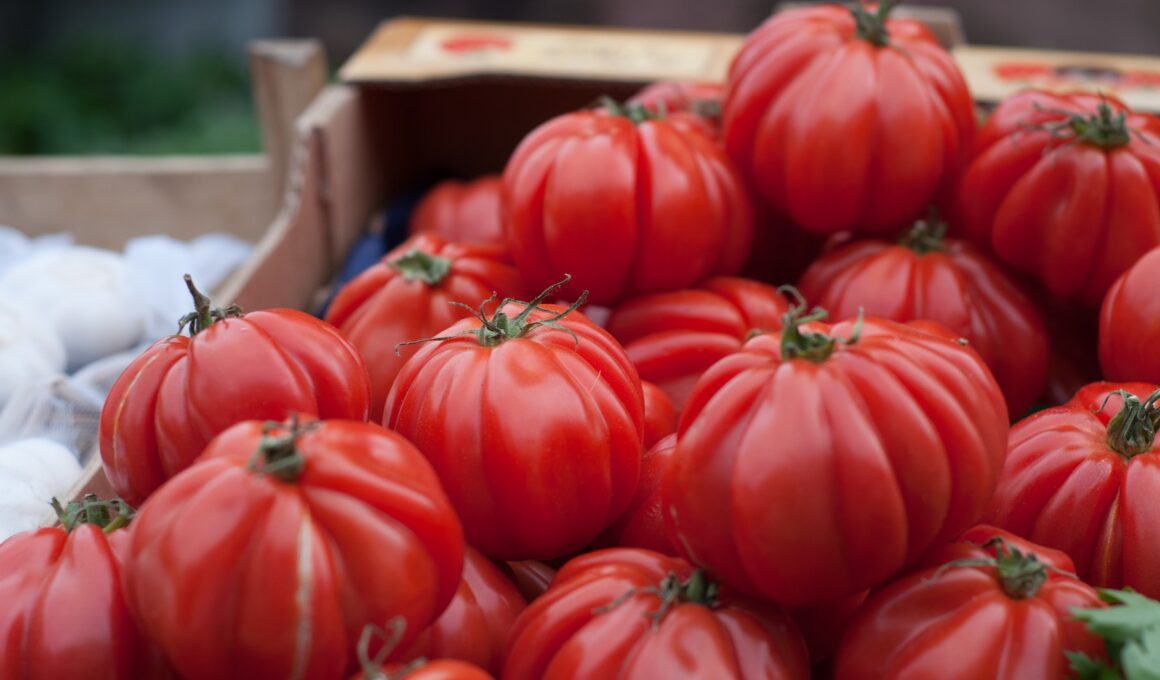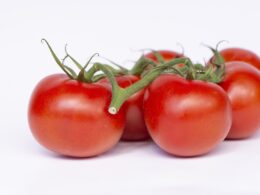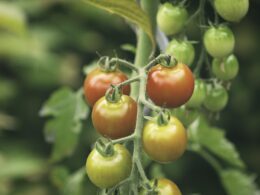Growing your own tomatoes can be a rewarding and delicious experience. You might be wondering how long it takes for those little seedlings to transform into plump, juicy tomatoes that you can enjoy in salads, sandwiches, or simply on their own.
Fear not, we’re here to guide you through the tomato growth process and help ensure a bountiful harvest from your garden.
There are several factors that affect how quickly your tomatoes will grow to full size, including the variety of tomato you choose and the growing conditions they’re exposed to.
In this article, we’ll discuss these factors and provide some tips on how to speed up the growth process so you can sink your teeth into those fresh homegrown tomatoes as soon as possible.
We’ll also share some advice on when it’s best to harvest your tomatoes for optimal flavor and enjoyment.
Let’s get started on our journey towards ripe, flavorful tomatoes!
Understanding the Tomato Growth Process
You’ll be amazed to witness the fascinating journey of a tiny tomato seed transforming into a juicy, ripe fruit!
It all starts with planting the seeds in warm, nutrient-rich soil. As you nurture them with proper watering and sunlight, they’ll soon sprout and grow into small seedlings. This initial phase is crucial for establishing a strong root system that will support your tomatoes throughout their growth.
As the seedlings continue to grow, they’ll develop leaves and stems. With enough sunlight, water, and nutrients from the soil, they’ll start producing flowers. These delicate blossoms attract pollinators like bees and butterflies that help with fertilization. Once successfully fertilized, the flowers will slowly transition into tiny green fruits – this is when you know your tomatoes are on their way!
Over time, these little green gems will mature and gradually change color as they ripen – usually from shades of green to vibrant reds or yellows depending on the variety. During this stage, it’s essential to keep an eye on their progress while ensuring they’re still receiving adequate care.
You can expect most tomato varieties to reach full size in about 60-100 days after planting – but remember that patience is key! So sit back and enjoy watching nature work its magic as you anticipate harvesting those delicious homegrown tomatoes.
Factors Affecting Tomato Growth Time
Keep in mind that factors such as climate, soil conditions, and the tomato variety you’ve chosen will impact the time it takes for your tomatoes to reach maturity. If you want to ensure that your tomatoes grow at a steady pace and remain healthy throughout their development, it’s essential to be aware of these factors and adjust your gardening practices accordingly. By doing so, you’ll not only enjoy a bountiful harvest but also have peace of mind knowing that you’ve provided the best possible environment for your plants.
Here are five key factors that can affect tomato growth time:
-
Climate: Tomatoes thrive in warm weather with temperatures between 65°F and 85°F. Too hot or too cold temperatures may slow down their growth.
-
Soil conditions: Well-draining soil rich in organic matter is ideal for tomato plants. Poor-quality soil may hinder root development and nutrient absorption.
-
Tomato variety: Depending on the type of tomato plant you choose (determinate or indeterminate), the growth rate may vary from 45 to more than 100 days until full maturity.
-
Watering schedule: Consistent moisture is crucial for proper tomato growth; both overwatering or underwatering can lead to stunted growth and other issues.
-
Sunlight exposure: Tomato plants need at least six hours of direct sunlight daily for optimal growth. Insufficient sunlight could delay fruit production.
By considering these factors when planting your tomatoes, you increase their chances of growing healthy and reaching full size within the expected timeframe. Remember to carefully select a suitable location for planting, pay attention to watering needs, monitor temperature fluctuations, provide proper nutrients through soil amendments if needed, and use appropriate support structures like cages or stakes if growing indeterminate varieties.
This way, you’ll feel secure knowing that you’ve done everything possible to promote strong, steady growth – which ultimately means delicious tomatoes waiting for you at harvest time!
Average Growth Time for Common Tomato Varieties
So, you wanna know the average growth time for common tomato varieties? Let’s dive into the world of Cherry Tomatoes, Slicing Tomatoes, and Beefsteak Tomatoes.
We’ll explore how long it takes for each type to grow and what factors can influence their growth time.
Cherry Tomatoes
Cherry tomatoes typically reach their plump, juicy maturity in about 60 to 80 days from planting, making them an excellent choice for gardeners who want a quick and bountiful harvest. These little gems are not only easy to grow, but they also provide a sense of accomplishment and safety as you enjoy fresh produce from your own backyard.
To ensure the best growth and flavor, make sure to pick a sunny spot for your cherry tomato plants, give them plenty of water, and fertilize regularly. By nurturing your plants with love and care, you can look forward to harvesting handfuls of these sweet, bite-sized fruits. They bring warmth and satisfaction to both your taste buds and heart.
Slicing Tomatoes
Slicing tomatoes, on the other hand, offer a myriad of culinary possibilities and are well worth the effort it takes to cultivate them. These larger tomatoes are perfect for sandwiches, salads, and sauces.
In general, slicing tomatoes can take anywhere from 60 to 85 days to grow from seedlings to full size. The time it takes depends on factors such as the variety you choose and your local growing conditions.
To ensure your safety and success in growing slicing tomatoes, be sure to provide proper care by giving them plenty of sunlight (at least six hours a day), consistent watering, and support with cages or stakes as they grow taller.
Keep an eye out for pests like aphids or tomato hornworms that could harm your plants, as well as any signs of disease. By taking these precautions and giving your plants the attention they need, you’ll be rewarded with delicious slicing tomatoes that make all your favorite dishes even better.
Beefsteak Tomatoes
When it comes to beefsteak tomatoes, you’ll find that they’re perfect for adding a juicy and flavorful touch to your culinary creations. These large, meaty tomatoes are ideal for slicing and can elevate the taste of any dish.
As one of the most popular varieties, growing beefsteak tomatoes in your own garden ensures you have access to fresh, delicious produce while providing a sense of security knowing exactly where your food is coming from.
To grow beefsteak tomatoes successfully and achieve their full size potential, follow these simple steps:
- Choose a sunny location: Tomatoes need at least 6 hours of direct sunlight per day to thrive.
- Prepare the soil: Mix in compost or organic matter to create nutrient-rich soil with good drainage.
- Plant seedlings: Space tomato plants about 2 feet apart to give them ample room to grow.
- Water regularly: Keep the soil consistently moist but not overly wet; maintain a balance by watering deeply every few days.
- Support growth: Use stakes or cages to support the plants as they grow taller and heavier with fruit.
By following these guidelines and nurturing your beefsteak tomato plants with care, you can expect them to reach their full size within 80 to 100 days after transplanting.
With proper attention and patience, you’ll be rewarded with an abundant harvest that brings both satisfaction and safety through homegrown produce.
Tips for Speeding Up Tomato Growth
Eager to harvest those juicy red fruits faster? Check out these tips that’ll help speed up your tomato plants’ growth! First, choose a fast-maturing variety like Early Girl or Celebrity. These types of tomatoes will reach maturity quicker than others.
Next, make sure you’re planting them in a sunny spot with well-draining soil. Tomatoes thrive on sunlight, so the more they get, the faster they’ll grow. To give your tomatoes an extra boost, consider using a high-quality fertilizer specifically designed for tomatoes. This will provide your plants with the essential nutrients they need to grow strong and healthy.
Additionally, be sure to water consistently and deeply – inconsistent watering can stunt growth and lead to problems like blossom end rot. To avoid this issue, try using a drip irrigation system or soaker hose for even watering throughout the season.
Another key factor in speeding up tomato growth is proper pruning. Remove any non-productive branches or suckers that aren’t producing fruit as this will allow the plant to focus its energy on growing larger tomatoes instead of wasting it on unnecessary foliage.
By following these tips and giving your tomato plants plenty of attention and care, you’ll be enjoying delicious homegrown tomatoes before you know it!
Harvesting and Enjoying Your Homegrown Tomatoes
Now that you’ve successfully grown your tomatoes, it’s time to enjoy them!
Let’s discuss how to determine when they’re ripe, the best ways to store them, and some helpful tips for using your homegrown tomatoes in delicious recipes.
Just follow these simple steps and you’ll be savoring the fruits of your labor in no time.
Determining Ripeness
It’s essential to recognize when your juicy red gems are ready for harvest, as timing plays a key role in determining their ripeness.
One of the easiest ways to check if your tomatoes are ripe is by observing their color and texture. Typically, a fully ripe tomato will have a deep, vibrant red hue and slightly tender skin that yields to gentle pressure from your fingers. However, keep in mind that some varieties may have different colors when ripe, such as yellow or green.
To ensure you’re picking tomatoes at their peak flavor and nutritional value, try the taste test. Gently twist a tomato off its vine and take a small bite – it should taste sweet and tangy with just the right amount of acidity. If it’s not quite there yet, don’t worry! Just give them a little more time on the vine until they reach perfection.
Remember that patience is key when it comes to growing delicious homegrown tomatoes; by waiting for the optimal moment to pick them, you’ll be rewarded with an abundance of fresh produce that is both safe and satisfying to eat.
Storage and Usage Tips
You’ve finally harvested those mouthwatering tomatoes, so let’s dive into some helpful storage and usage tips to make the most of your scrumptious bounty!
First things first, don’t store your fresh tomatoes in the fridge – the cold can make them lose their flavor and become mushy. Instead, keep them at room temperature on a kitchen counter or in a cool pantry. Place them stem-side down to prevent bruising and extend their shelf life.
When it comes to using your tomatoes, wash them thoroughly before eating or cooking with them. You can easily remove the skins by blanching if needed for certain recipes like sauces or soups.
To preserve any extras beyond their prime, try freezing, canning, or dehydrating them for future use.
With these simple storage and usage tips, you’ll be enjoying delicious and safe tomato dishes all season long!
Conclusion
In conclusion, growing tomatoes can be a rewarding experience. Keep in mind the factors that affect tomato growth and choose the right variety for your garden. With proper care and patience, you’ll enjoy delicious homegrown tomatoes in no time.
Remember to follow our tips for speeding up growth and harvesting at the perfect time. Enjoy your tasty tomatoes in salads, sauces, or just as a healthy snack!









